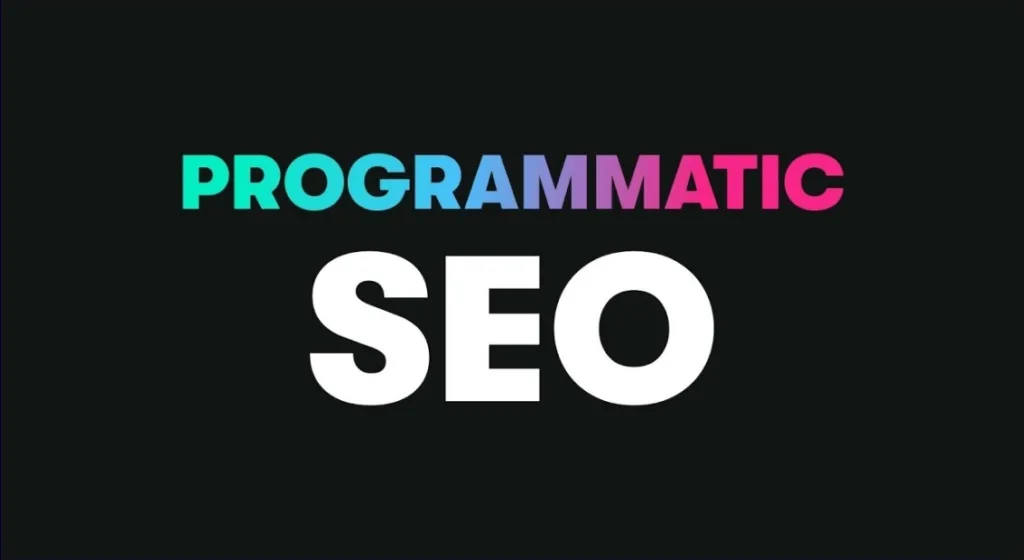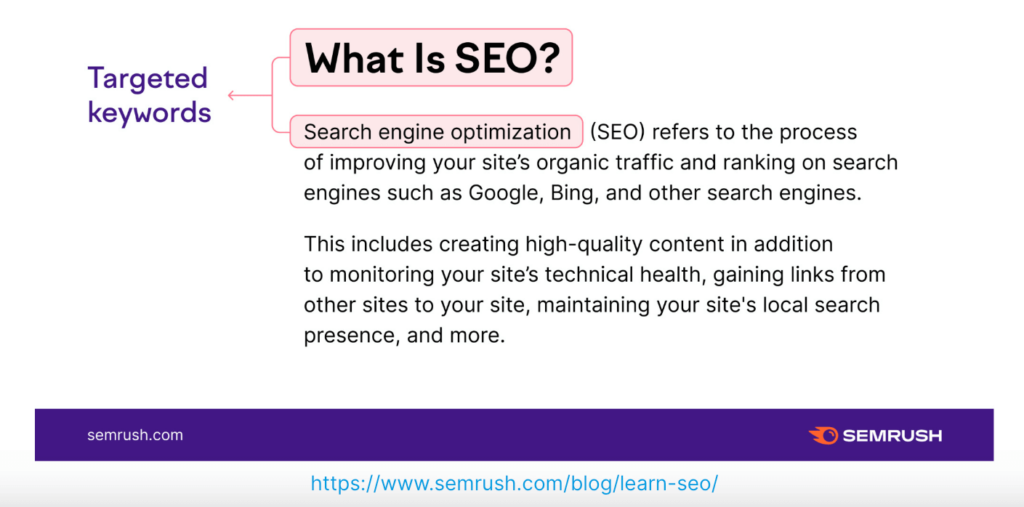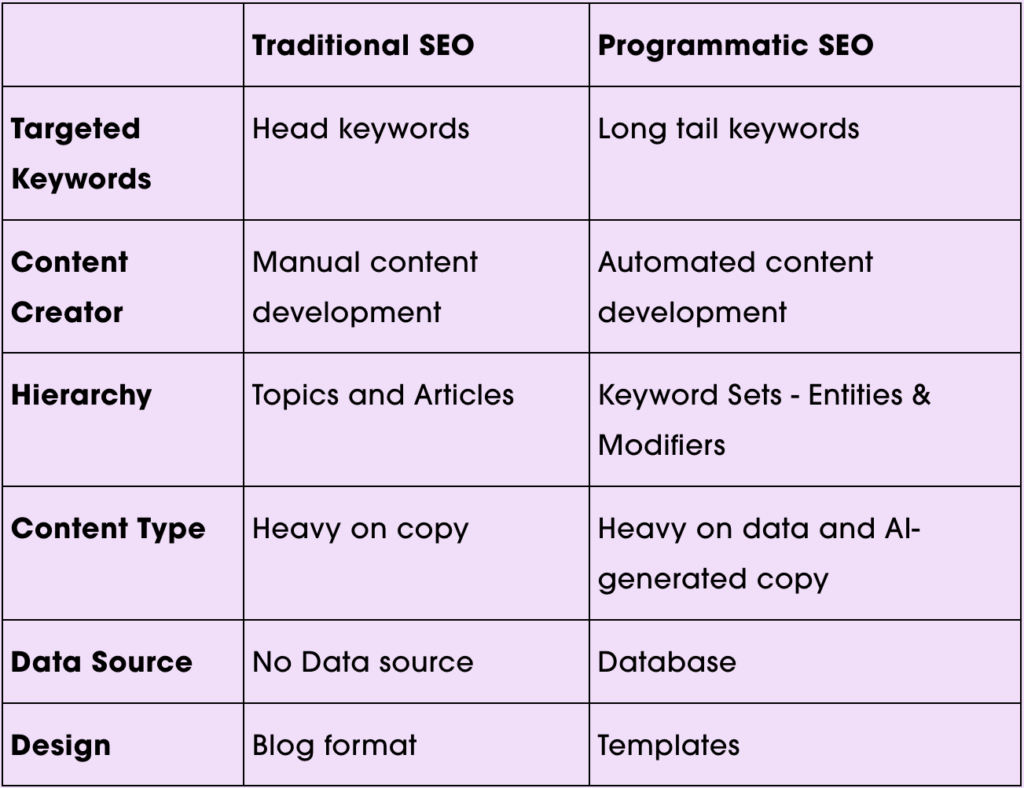
Google emphasizes quality content as one of the best ways to market your company’s website. As you know, creating useful, relevant content that ranks for targeted keywords is not a simple process. Quite a bit of analysis is done first, followed by deliberate, manual content creation. Once you accomplish this, the goal is to replicate the same quality for all your landing pages. What if there was a way to create and publish over 1,000 pieces of content within that same time frame? With programmatic Search Engine Optimization (pSEO), that opportunity exists.
Traditional SEO provides the standards for growing your website’s traffic. True, it’s a time-consuming process, but one that reaps quantifiable rewards. If you consistently publish high-quality content, you will see results in organic search, website traffic, and revenue. Depending on the scale of your SEO campaigns, you may hire an agency to write the content and manage your overall SEO.
In this article, we will introduce pSEO and its ability to publish thousands of SEO pages in a matter of days rather than months. Some companies have found so much success with this method that they have rooted it as the foundation of all their marketing endeavors. What makes it so different and more effective than traditional SEO?
SEO Basics
Before we get into the characteristics of pSEO, let’s refresh our definition of traditional SEO. Traditional SEO has been the long-running standard for creating compelling, long-form landing pages that focus on topics related to the company’s target audience.
SEO is the process of optimizing your web pages so that select pages rank highly on Google and other search engines. A large portion of SEO is creating blog content that ranks for targeted keywords. Doing so ensures that visitors who search Google for a particular keyword see one of your content pages in the Search Engine Results Pages (SERPs), ideally within the top 10 results. Equally as important is search intent. Searchers should find what they are looking for on the landing page as opposed to being led by keywords but finding no relevant content.

What is Programmatic SEO?
While pSEO operates under the same principles as traditional SEO, the difference is in volume and scale. pSEO creates bulk SEO-optimized pages for the website all at once, all with the same goal of ranking high on Google searches. This is accomplished by way of using existing data and applying pre-programmed rules. In order to reach as many people as possible, pSEO creates hundreds to thousands of landing pages to ensure their links receive the most clicks. This drives website traffic and increases revenue by making these relevant pages accessible to potential customers.
For example, Yelp employs pSEO to reach its intended audience. They have an independent website for each form of business search. Another example is Tripadvisor, which also has websites for almost every aspect of travel. In fact, they have a website for just about every city worldwide with the same organization and information on every page. In both examples, users can enter just about any search term related to a business search or travel, and they will see Yelp or Tripadvisor on Page 1 of Google’s search results.

Traditional SEO vs. Programmatic SEO
So far, we have talked about pSEO’s volume regarding landing pages. This marks the critical difference between traditional SEO and pSEO. Each methodology has a different approach to content creation.
Traditional SEO targets head keywords embedded in manually created content. Produced by copywriters, this manual content is most often chunked into topics and published as articles.
Programmatic SEO uses automated content development and targets something called long-tail keywords. Templates are used to organize content that targets specific keyword sets, which are programmatically built on entities and modifiers. This is mainly data-driven, through a database like SQL or Airtable.
To further amplify the product, Artificial Intelligence (AI)-generated content is pulled into the database through an Application Programming Interface (API) from models such as Generative Pre-trained Transformers (GPT). Thus, pSEO is extensively automated, making it easier to produce content on a large scale, much more so than traditional SEO’s laborious manual work.
Benefits of Programmatic SEO Over Traditional SEO
Programmatic SEO offers several benefits that make it advantageous over traditional SEO. First, the primary goal of pSEO is to attract the highest volume of organic search traffic possible. To that end, pSEO far outperforms traditional SEO.
A pSEO campaign can significantly increase a website’s visibility, domain authority, and link-building opportunities. More than just getting users to click the link, a successful pSEO campaign creates a rich User Experience (UX) because the user finds authoritative, quality content that addresses their search intent.
Other pSEO advantages include the following.
Scalability
pSEO is ideal for large-scale content. Because content is automatically generated, more can be produced with less effort, providing considerable cost savings. Automatically generated content makes executing a large-scale website project practical and cost-effective. In addition, you can add data continuously as you go, expanding the scope as desired.
Speed
Programmatic SEO is hands down the fastest way to deploy a website. You can create landing pages within seconds using data automation. pSEO also reduces dependency on engineers, enabling marketers to make quick changes to all the landing pages themselves rather than by outsourcing.
Unique Content
One of pSEO’s benefits is that its resulting content is designed to be unique so that you stand apart from the competition. The standard blog content remains effective. However, today’s content landscape demands more. Content must provide value to the reader. Programmatically generated pages can address this need for value and relevance.
Consistent Design
With pSEO, the content on each generated page is formatted the same way using a headless Content Management System (CMS). A headless CMS separates the content presentation layer from the back end, where content management happens. This way, you can manage the content from a central location and deploy it to multiple channels. Separating these layers allows for automation of builds, changes, and scaling.
Templated pages can be replicated and modified easily. With them, you can create a reusable library of content page components and design elements.
How to Create Programmatic SEO Pages
While there’s no universal approach to developing pSEO pages, the following components should be part of every pSEO strategy.
1. Planning and Keyword Research
Identifying keywords is the cornerstone of pSEO (as it is with traditional SEO). Your first task is to identify a head term and modifiers, with which you can determine the search volume for relevant and profitable keywords. You don’t necessarily need keywords with thousands of searches a month. Rather, thousands of keywords with some search volume will work well because they are less competitive.
Ways to search for keywords include viewing your competitors and analyzing customer feedback. Of course, keyword research tools can streamline these tasks for you.
2. Design the Page Template
Before building your content database, take a step back and determine the look and feel of your page. That will also identify the type(s) of content you’ll need to populate your templated pages. Your focus at this point is to ensure you’re meeting user intent. With that in mind, be sure your page contains the correct content type. It should be accurate, complete, and helpful to the user. Skipping this step means you miss an essential mark (user intent). It can also result in Google not indexing your pages.
3. Identify and Collect Data
This process will differ for each site, depending on how the site is constructed. For example, some sites have dynamic content that requires daily updates, while others do not. Here is where you conduct the research that will result in robust content.
You can accomplish this in several ways. The most common methods are manually collecting private data, scraping websites, manual entry, or gathering user-generated content.
4. Build the Database
Now, you can start building your database. You’ll create the specific fields and map them to each piece of content (including images) for the page. You’ll also include the required metadata, such as URL, page title, and description. Because you already have a working template, creating these fields is straightforward. You create a field for every piece of content on the page.
This part does take some time, as you may have hundreds of rows to populate. There are tools out there to assist you in building your database. These are especially helpful for people with little database or coding knowledge. One tool is Airtable, a low-code database tool that can assist you in this process.
5. Build, Connect, and Test
At this point, you are ready to start gathering your CMS collection for your site. As you build your CMS, select which database fields are needed to populate the page template. Once that’s complete, connect the database to your website so it can populate the corresponding fields. If you sync the two properly, the web pages will update each time you update the database.
Once you complete all these tasks, test to be sure the site works as it should across all browsers and devices. Everything you programmed in page content and metadata should appear correctly. Also, run a test to ensure that the site is adequately indexed.
Programmatic SEO Disadvantages
As powerful as pSEO is, there are some disadvantages to note and watch out for should you choose to use it as part of your digital marketing strategy. You’ll want to review these areas during the development process to ensure you mitigate any issues that arise.
Duplicated Content
If you reuse the same data across multiple pages, you risk creating nearly identical pages. It takes some skill to formulate your fields and data so that you produce totally unique pages. A realistic goal is to ensure 80% of your content is unique. If Google recognizes too much duplicate content, it can apply unwelcome penalties to your site.
Thin Content
If your pSEO sites are populated with visuals like graphs or infographics and little text, Google may recognize that as thin content and lower the page rank. Even though visuals are a way to make content easier to digest and visually appealing, the lack of text on pages is a problem.
One way to correct this is to add detailed descriptions to your graphics in metadata, alt text, and on the page itself.
Crawlability
Because pSEO creates high page volume by design, there is a risk Google won’t properly index some of those pages. One way to mitigate this risk is to strengthen the interlinking between them on your website.
Manual Review and Penalties
If you publish thousands of pages simultaneously, Google may trigger a manual evaluation of your site and possibly apply penalties. Google’s algorithms are set to identify unusual publication actions. One way to avoid this issue is to post your pages in batches rather than all at once.
Keyword Cannibalization
Programmatic page creation often results in a group of websites devoted to similar (if not identical) themes and keywords. The result is keyword cannibalism, which occurs when Google cannot identify which page should rank for a phrase. As a result, none of the pages rank at all. To counter this, ensure that each of your web pages is unique.
Conclusion
Programmatic SEO has been around for years, but it has recently attracted renewed interest. Part of this renewed interest is the advent of affordable, user-friendly tools (Airtable and others) that allow more people to build pSEO pages. Previously, you would have to hire a team of engineers and designers to gather and assemble the data. In addition, the advance of Open Artificial Intelligence (OpenAI) automates data collection and content creation to scale, making pSEO even more powerful. AI-written content is becoming widely accepted and employed in traditional SEO as well.
With pSEO, you create a dedicated page for every product, category, or service on your website. More importantly, you can create these pages through automation, which saves valuable time and money.
Because each page is tailored to a specific keyword(s), the pages will rank well in organic search results. Thus, you can ensure more of your content places in those organic search results with less effort on your part. The key is to conduct a proper keyword search upfront to determine your search terms. Your chosen pSEO tools will take it from there.
Programmatic SEO can potentially drive incredible amounts of traffic to your website without using valuable human resources. You don’t need to hire extra staff or contract with a third-party provider. However, if you have questions regarding pSEO or need assistance with keyword research, don’t hesitate to contact us for a consultation.